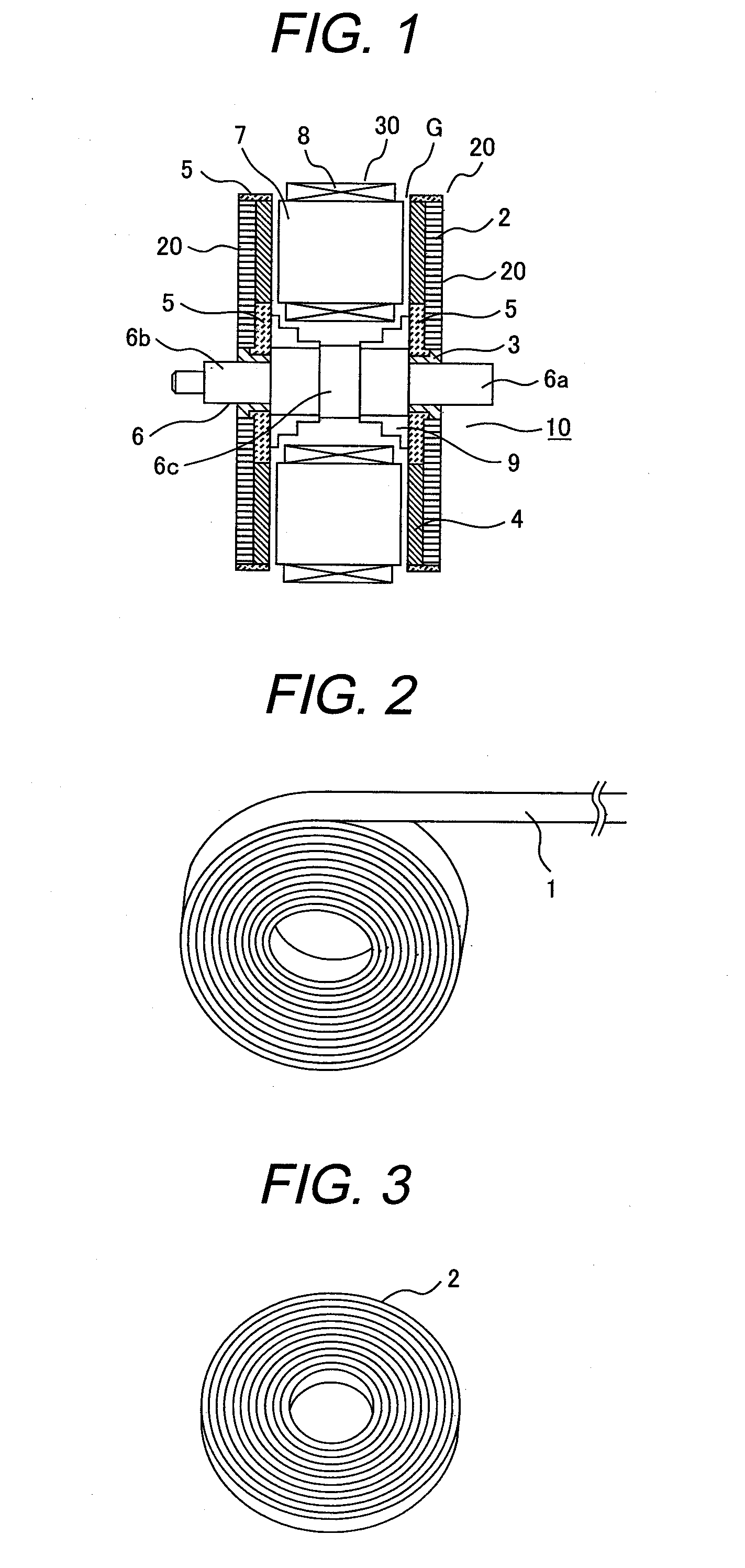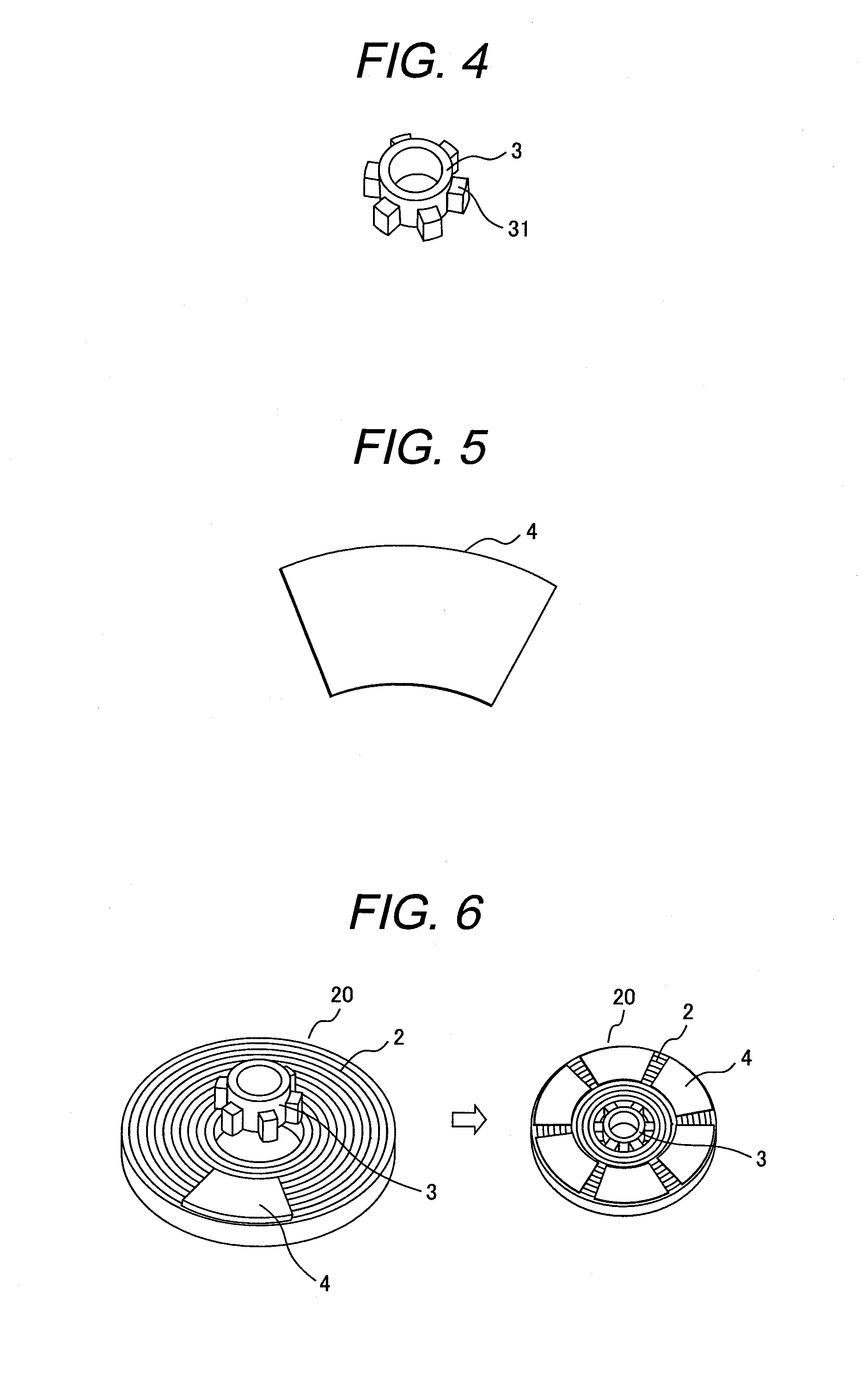Axial gap rotating electrical machine and rotor used therefor
a technology of axial gap and rotor, which is applied in the direction of dynamo-electric machines, magnetic circuit rotating parts, and shape/form/construction of magnetic circuits, etc. it can solve the problems of limiting the degree of freedom in changing the shape of magnets, increasing the cost of manufacturing, and eddy current loss, so as to reduce eddy current loss, reduce the cost of rotor, and simplify the manufacturing process
- Summary
- Abstract
- Description
- Claims
- Application Information
AI Technical Summary
Benefits of technology
Problems solved by technology
Method used
Image
Examples
first embodiment
[0030]A first embodiment of the present invention will now be described with reference to FIGS. 1 to 7.
[0031]FIG. 1 shows an example of an axial gap motor according to the first embodiment of the present invention. In FIG. 1, a rotor and a stator are shown with a motor housing removed (not shown).
[0032]The axial gap motor 10 is configured so that a rotor 20 and a stator 30 are opposed to each other in an axial direction of a rotor shaft 6 with a gap G. The present embodiment examples the axial gap motor including two rotors and one stator in order to provide enhanced motor efficiency but it doesn't limit such a type thereof.
[0033]Referring to FIG. 1, each of electromagnets, which constitute the stator 30, is formed by a coil-mounted stator core which is obtained by mounting an electromagnetic coil 8 on each stator core 7. The electromagnetic coil 8 is wound around the stator core 7 in such a manner that its center is positioned in parallel with the axis of the rotor shaft 6. Plural ...
second embodiment
[0048]A second embodiment of the present invention will now be described. FIGS. 8 to 11 illustrate a rotor structure of an axial gap motor according to the second embodiment.
[0049]The rotor according to the present embodiment also uses an amorphous ribbon wound toroidal core as the rotor yoke 2, as is the case with the first embodiment. The rotor according to the present embodiment differs from the rotor according to the first embodiment in that the amorphous ribbon wound toroidal core 2 is formed by winding the amorphous magnetic metal ribbon 1 directly onto a rotor shaft 6′, as shown in FIG. 9, without using a rotor shaft use boss. In other words, the rotor yoke 2 formed by the amorphous ribbon wound toroidal core is directly mounted on the rotor shaft 6′.
[0050]FIG. 8 shows the rotor shaft 6′ used in the present embodiment. Portions 6a′, 6b′, 6c′ of the rotor shaft 6′ respectively correspond to the portions 6a, 6b, 6c shown in FIG. 1. The portion 6c′ of the rotor shaft 6′ is a por...
third embodiment
[0056]A third embodiment of the present invention will now be described. FIGS. 12 to 14 illustrate a rotor structure of an axial gap motor according to the third embodiment.
[0057]The axial gap motor according to the present embodiment includes one rotor and two stators.
[0058]FIG. 12 shows the amorphous ribbon wound toroidal core 2 as the rotor yoke is formed by directly winding an amorphous magnetic metal ribbon onto a shaft 6, in the same manner as indicated in FIG. 9, at the rotor yoke position of an axial central portion 6d″ (see FIG. 14) of a rotor shaft 6″. Portions 6a″ and 6b″ of the rotor shaft 6″ correspond to portions 6a and 6b in the first embodiment and are supported by the motor housing via a radial bearing (not shown). The present embodiment is similar to the foregoing embodiments in that the amorphous ribbon wound toroidal core 2 is impregnated with resin 5.
[0059]In the present embodiment, the same magnets 4 as in the first and second embodiments are bonded to both sur...
PUM
 Login to View More
Login to View More Abstract
Description
Claims
Application Information
 Login to View More
Login to View More - R&D
- Intellectual Property
- Life Sciences
- Materials
- Tech Scout
- Unparalleled Data Quality
- Higher Quality Content
- 60% Fewer Hallucinations
Browse by: Latest US Patents, China's latest patents, Technical Efficacy Thesaurus, Application Domain, Technology Topic, Popular Technical Reports.
© 2025 PatSnap. All rights reserved.Legal|Privacy policy|Modern Slavery Act Transparency Statement|Sitemap|About US| Contact US: help@patsnap.com



